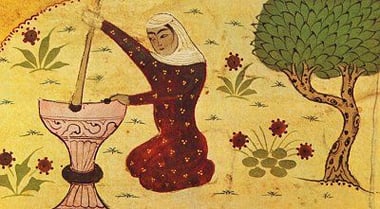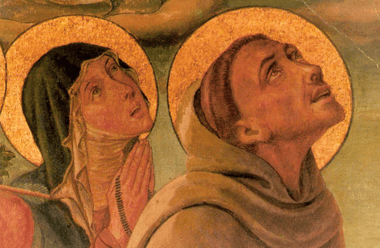.jpg?width=723&name=Hildegard_von_Bingen%20(1).jpg)
United offers a variety of courses, including introductory courses, such as Intro to Theology, and practical courses, such as Preaching. But how do some of the more esoteric-sounding courses prepare students for their vocations after graduation?
Last semester, Dr. Jennifer Awes Freeman offered a course on Medieval Women Mystics. Students read writing from St. Perpetua in the 3rd Century up through late Medieval and Renaissance mystics like Teresa of Ávila. They studied Non-Christian mystics including Buddhist Yeshe Tsogyal and Muslim Rabia. While a diverse group, many of these mystics experiences of divinity differed from most male contemporary theologians, indeed most theologians into the modern era. By studying the writings of medieval women mystics, students can become better faith leaders.
 Rabia
Rabia
Contemplative Models
Medieval women mystics wrote down visionary and meditative practices. Some contemplated icons of Mary or Jesus. Others wrote books on meditation. Teresa of Avila’s The Interior Castle depicts the soul as a castle with different layers. An individual “travels” through different layers, gaining new insight, until reaching the central ring of union with God. Several students connected Teresa’s practice to their own. One student found Teresa’s writing to be a helpful companion to her own Buddhist meditative practice. Medieval women mystics can equip faith leaders with contemplative exercises and meditation practices.
Embodied Ministry
An important theme in medieval women writing is embodiment. Physical spirituality included the fasting practices of Clare of Assisi or the Sufi Rabia who traded physical sustenance for spiritual. At the same time, mystic women fed for the needy, sometimes miraculously. Likewise treating disease and wounds was part of their ministries. Hildegard of Bingen was exceptionally skilled in healing and wrote manuals on biology and anatomy. For her, studying bodies helped her better understand the divine, since humans were made in the image of God. Meanwhile Beguines, living outside the church, found proximity to the poor and sick brought them closer to Christ.
Mystics show how leaders can center bodies. Food might play a key role in ministry. Clare’s writings can instruct when, why and how to observe fasts. Revelations among the sick and starved rethink chaplaincy not only as service but embodied theological practice.
 Clare and Francis of Assisi
Clare and Francis of Assisi
Erotic Theologies
Related to embodied ministry is the erotic in medieval women mysticism., Yeshe Tsogyal’s philosophy included tantric sexual practices: erotic bonds with her mentor that helped her understand nondualism. Many other mystics were chaste but experienced erotic relationships with Christ in their visions. Clare, the Beguines, Teresa envisioned bridal unions with Christ. Mystical consummation with the divine husband led to cosmological insight, knowledge of self and of God.
The erotic in these texts challenges us to explore what desire and sexual experience have to teach us about divine love. Some students wrote plays about the erotic sides of God or considered how the sensuality of divinity might be utilized in chaplaincy contexts. Faith leaders can learn from the reflexive ways Medieval mystics use their passionate, romantic and erotic selves for their ministry.
 Catherine of Siena
Catherine of Siena
The Divine Feminine
Beside the erotic, many mystics experienced God’s love as maternal. Julian of Norwich presents a divine trinity of Father, Mother and spouse. She compared Christ’s blood with mother’s milk: as a mother nurtures her child, Christ nurtures the people of the world. Mystics with more traditional ideas of God exalted the divine feminine through the figure of the Virgin Mary, composing hymns for her feminine creativity. Others meditated by imagining themselves as Mary holding the infant Christ.
Students, who were themselves mothers, related to God and Mary in new ways. Others created artistic adaptations of the feminine divine for final projects, celebrating the sacredness of female bodies, birth and maternal love. Religious leaders can use these medieval authors to counter a singular image of a male God and inspire women to see themselves as reflecting divinity.
 Clare of Assisi saving a Child from a Wolf
Clare of Assisi saving a Child from a Wolf
In Medieval Women Mystics students encounter writings they might be unfamiliar with and end up with new skills, ideas for ministry, and concepts of God. Unconventional classes like Sex & Religion in the Public Square, Contemporary Pastoral Theologians: Audre Lorde and Prince or, indeed, Medieval Women Mystics address spiritual leadership in unique ways. As professors create electives that showcase their academic areas of interests, students are challenged to think outside the box and become better faith leaders.




Your Comments :